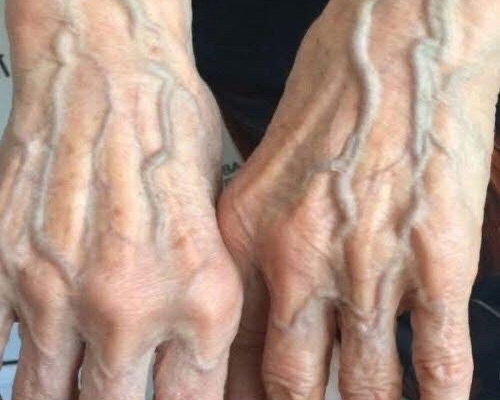What Your Hand Veins Can Reveal About Your Health
Our bodies often communicate with us in subtle ways, and one of the most overlooked areas for health clues is our hands. While most of us think of the hands simply as tools for work, creativity, or expression, they can also serve as a visible indicator of what might be happening internally. The appearance of veins, especially when they seem more noticeable than usual, can sometimes spark concern. In most cases, visible veins are harmless and related to natural factors such as aging, exercise, or skin thickness. However, in some instances, changes in the look of your hand veins can point to underlying health conditions that deserve more attention.
This article explores the many reasons why veins in the hands may suddenly become more prominent. We will also discuss potential lifestyle causes, medical explanations, prevention strategies, and when it may be wise to consult a healthcare professional. By the end, you will have a well-rounded understanding of what visible veins might mean and how to respond appropriately, ensuring both peace of mind and proactive health management.
Why Do We See Veins in the Hands?
The human circulatory system is a vast network of arteries, veins, and capillaries responsible for transporting oxygen and nutrients throughout the body. Veins, specifically, carry blood back to the heart. Unlike arteries, which are positioned deeper and surrounded by thicker muscle, veins are closer to the skin’s surface. This proximity is why they can often be seen more clearly, especially in areas where skin is naturally thinner, such as the backs of the hands.
Factors That Make Veins More Visible
-
Aging
As we grow older, our skin loses collagen and elasticity. This thinning effect makes veins more noticeable, even if they have been present all along. Aging is a natural process, and visible hand veins are often nothing more than a cosmetic change. -
Physical Activity
Athletes, weightlifters, and even those who perform regular moderate exercise often notice more prominent veins. During exercise, blood flow increases, and veins temporarily expand to accommodate greater circulation. Over time, consistent physical activity can make this vascularity appear permanent. -
Body Composition
People with lower body fat levels often have more visible veins. With less fat between the skin and the veins, the vessels stand out more prominently. This is why sudden weight loss can make hand veins appear even if they were not noticeable before. -
Genetics
Some individuals naturally have more prominent veins due to hereditary factors. If your parents or grandparents had visible veins, there’s a good chance you might as well. -
Dehydration
When the body lacks adequate hydration, the skin can look thinner and less plump. This change can accentuate the visibility of veins that were already present but less obvious.
While these common causes are generally harmless, there are situations where bulging or twisted veins in the hands may be a signal that further medical evaluation is needed.
Medical Explanations for Prominent Hand Veins
Although most cases are not serious, certain medical conditions can cause veins to bulge, twist, or become uncomfortable. Understanding these conditions can help you know when it is appropriate to seek professional advice.
Varicose veins occur when valves inside the veins stop functioning effectively. Normally, these valves prevent blood from flowing backward. When they fail, blood pools in the vein, causing it to enlarge, twist, and sometimes ache. Varicose veins are most commonly found in the legs due to gravity and pressure, but in rare cases, they can appear in the hands.
Key features of varicose veins in the hands may include:
-
Enlarged, rope-like veins
-
Occasional throbbing or discomfort
-
More visible bulging during prolonged standing or heat exposure
2. Venous Insufficiency
Chronic venous insufficiency happens when veins struggle to send blood back toward the heart. This condition is more common in the lower body but can affect the hands as well. Symptoms include swelling, a heavy sensation, and tingling. While less frequent in the upper limbs, it remains a potential cause of concern for visible hand veins.
Quick or extreme weight reduction reduces the layer of fat under the skin. As a result, veins that were once hidden become visible. This is not a dangerous condition on its own, but sudden, unplanned weight loss can indicate nutritional or metabolic issues that should be addressed.
Water plays a vital role in maintaining skin health and elasticity. When hydration levels drop, the skin contracts, and veins stand out more clearly. Athletes who sweat heavily, or individuals in hot climates, may notice their veins more when dehydrated.
5. Cardiovascular or Liver-Related Issues (Rare)
On rare occasions, prominent veins can signal broader health concerns, such as heart or liver problems. These are typically accompanied by additional symptoms, including fatigue, swelling throughout the body, or persistent discomfort. Though uncommon, it’s important not to dismiss such signs if they appear alongside vein changes.
When to Seek Medical Advice
Not every visible vein warrants a doctor’s visit, but certain warning signs should prompt further evaluation. You should consider contacting a healthcare professional if you notice:
-
Sudden, unexplained bulging veins that persist for more than a week
-
Pain, redness, or warmth around the veins
-
Numbness or tingling in the hands
-
General swelling that does not improve with rest or hydration
-
Associated symptoms like fatigue, shortness of breath, or abdominal discomfort
Medical evaluation may involve physical examination, ultrasound imaging, or blood tests to determine whether circulation problems are present.
Lifestyle Strategies to Support Healthy Veins
Even when visible veins are not a medical issue, maintaining good vascular health is beneficial for overall well-being. Here are practical tips that can reduce vein strain and improve circulation:
-
Stay Hydrated
Drinking enough water throughout the day keeps skin hydrated and helps blood flow efficiently. Aim for at least 6–8 glasses daily, more if you are physically active or in warm weather. -
Exercise Regularly
Moderate activities like walking, swimming, and yoga encourage healthy circulation. Resistance training can also strengthen veins but should be balanced with stretching and recovery to prevent strain. -
Maintain a Balanced Diet
Foods rich in antioxidants, vitamin C, and fiber support vein health. Citrus fruits, leafy greens, whole grains, and lean proteins are particularly helpful. -
Avoid Prolonged Immobility
Long hours at a desk or in one position can hinder circulation. Taking breaks to stretch and move around improves blood flow and prevents pooling in veins. -
Protect Your Skin
Since thin or damaged skin makes veins more visible, applying sunscreen and moisturizing regularly can help preserve skin elasticity. -
Manage Stress
Stress can elevate blood pressure and indirectly affect vascular health. Techniques such as meditation, deep breathing, or even short walks can reduce stress and promote circulation.
Treatment Options for Prominent or Problematic Veins
If veins in the hands are not just visible but also causing discomfort, several treatment methods may be recommended by healthcare professionals.
-
Conservative Care
-
Wearing compression gloves or sleeves to support blood flow
-
Elevating the hands periodically to reduce swelling
-
Applying cool compresses to relieve discomfort
-
-
Medical Interventions
-
Sclerotherapy: A minimally invasive treatment where a solution is injected into the vein, causing it to collapse and fade.
-
Laser Therapy: Uses focused light to close off small problematic veins.
-
Surgical Options: Rarely needed for hand veins but considered in severe venous insufficiency cases.
-
Holistic and Preventive Approaches
In addition to medical options, some people find relief through complementary approaches. These are not replacements for professional care but can be supportive when used responsibly:
-
Herbal supplements like horse chestnut extract or grape seed extract, believed to promote vein tone (consult a healthcare provider before use).
-
Massage therapy to encourage circulation and relaxation.
-
Hydrotherapy (alternating warm and cool water) to stimulate blood vessels.
Final Thoughts
Visible veins in the hands are a common experience and, in most cases, a normal variation influenced by age, activity, or body composition. However, when changes happen suddenly or are paired with discomfort, it is wise to pay attention and consult a medical professional. Early attention can ease concerns, prevent complications, and ensure long-term vascular health.
By supporting your circulatory system through hydration, balanced nutrition, regular movement, and stress management, you can promote healthier veins and overall well-being. Remember: your body often signals when it needs care, and something as simple as a change in your hand veins can be the first step toward a more mindful relationship with your health.



